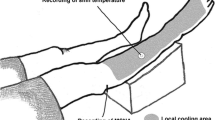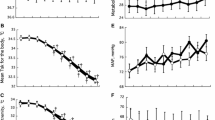Abstract
The lack of control procedures inherent in most of the experiments conducted to assess the effectiveness of skin temperature biofeedback in the treatment of Raynaud's disease renders the results inconclusive. In this study, control groups and a double-blind approach are adopted. Thirty-six patients, carefully screened for a diagnosis of primary Raynaud's disease, were assigned to a skin temperature increase group (N=12), to an EMG relaxation control group (N=12), or to a notreatment control group (N=12). All patients kept records of their symptoms for the duration of the study. Each subject in the two training groups received 20 sessions, the last 2 conducted under cold stress. Data analysis according to original group assignment, as well as following regrouping of subjects according to several learning criteria, showed that while all patients reported a marked decrease in the number of vasospastic attacks, no significant differences were found among the three groups on the clinical measures used to assess symptomatic relief. The general improvement reported must therefore be attributed to nonspecific factors.
Similar content being viewed by others
Reference notes
Peper, E.Case report. Paper presented at the annual meeting of the Biofeedback Research Society, Boston, 1972.
Carlson, J. G. (Chair).Biofeedback as a research tool (Biofeedback Society of America Task Force Study Section Report). Denver: Biofeedback Society of America, 1978.
Sdorow, L. M., & Masterson, J.Effects of knowledge of target response, feedback, and direction of change on self-control of fingertip temperature. Unpublished manuscript, Department of Behavioral Sciences, St. Francis College, Loretto, Pennsylvania, 1977.
References
Abramson, D. I.Vascular disorders of the extremities (2nd ed.). Hagerstown, Maryland: Harper & Row, 1974.
Adair, J. R., & Theobald, D. E. Raynaud's phenomenon: Treatment of a severe case with biofeedback.Journal of the Indiana State Medical Association 1978,71 990–993.
Alberstein, B. Biofeedback and skin temperature control.Psychophysiology 1977,14 115. (Abstract).
Allen, E. V., & Brown, G. E. Raynaud's disease: A critical review of minimal requisites for diagnosis.American Journal of the Medical Sciences 1932,183 187–200.
Blanchard, E. B., & Epstein, L. H. The clinical utility of biofeedback. In M. Hersen, R. M. Eisler, & P. M. Miller (Eds.),Progress in behavior modification (Vol. 3). New York: Academic Press, 1977.
Blanchard, E. B., & Miller, S. T. Psychological treatment of cardioavascular disease.Archives of General Psychiatry 1977,34 1402–1413.
Freedman, R., Lynn, S. J., & Ianni, P. Biofeedback treatment of Raynaud's phenomenon.Biofeedback and Self-Regulation 1978,3 230. (Abstract)
Gardner, E. T., & Keefe, F. J. The effects of knowledge of response on temperature biofeedback training.Biofeedback and Self-Regulation 1976,1 314. (Abstract)
Guglielmi, R. S.A double-blind study of the effectiveness of skin temperature biofeedback as a treatment for Raynaud's disease. Unpublished doctoral dissertation, University of Minnesota, 1979.
Guglielmi, R. S.The neurogenic basis of Raynaud's disease. Montreal: Eden Press, (in press).
Headrick, M. W., Feather, B. W., & Wells, B. T. Undirectional and large magnitude heart rate changes with augmented sensory feedback.Psychophysiology 1971,8 132–142.
Jacobson, A. M., Hackett, T. P., Surman, O. S., & Silverberg, E. L. Raynaud's phenomenon: Treatment with hypnotic and operant technique.Journal of the American Medical Association 1973,225 739–740.
Katkin, E. S., Fitzgerald, C. R., & Shapiro, D. Clinical applications of biofeedback: Current status and future prospects. In H. L. Pick, H. W. Leibowitz, J. E. Singer, A. Steinschneider, & H. W. Stevenson (Eds.),Psychology: From research to practice. New York: Plenum Press, 1978.
Keefe, F. J., Kopel, S. C. Gordon, S. B.A practical guide to behavioral assessment. New York: Springer, 1981.
Kewman, D. G., & Roberts, A. H. Skin temperature biofeedback and migraine headaches: A double-blind study.Biofeedback and Self-Regulation 1980,5 327–345.
Kirk, R. E.Experimental design: Procedures for the behavioral sciences. Belmont, California: Brooks/Cole, 1968.
Lippold, O. C. J. Electromyography. In P. H. Venables & I. Martin (Eds.),A manual of psychophysiological methods. Amsterdam: North-Holland, 1967.
Lynch, W. C., Hama, H., Kohn, S., & Miller, N. E. Instrumental control of peripheral vasomotor response in children.Psychophysiology 1976,13 219–221.
May, D. S., & Weber, C. A. Temperature feedback training for symptom reduction in primary and secondary Raynaud's disease.Biofeedback and Self-Regulation 1976,1 317.
Packer, L. E., & Selekman, W. L. Within-subjects control in EMG and thermal biofeedback training: The baseline effect.Biofeedback and Self-Regulation 1977,2 293–294.
Roos, D. B. Plethysmography: A simple method of studying and following peripheral vascular disorders.Surgical Clinics of North America 1969,49 1333–1342.
Sanchez, S. A. Strain gauge plethysmography: A diagnostic aid in obstructive arterial disease.Postgraduate Medicine 1966,39 451–457.
Sedlacek, K. EMG and thermal feedback as a treatment for Raynaud's disease.Biofeedback and Self-Regulation 1976,1 318. (Abstract)
Shapiro, D., & Schwartz, G. E. Biofeedback and visceral learning: Clinical applications.Seminars in Psychiatry 1972,4 171–184.
Shapiro, D., & Surwit, R. S. Learned control of physiological function and disease. In H. Leitenberg (Ed.),Handbook of behavior modification and behavior therapy. Englewood Cliffs, New Jersey: Prentice-Hall, 1976.
Shapiro, D., & Surwit, R. S. Biofeedback. In O. F. Pomerlean & J. P. Brady (Eds.),Behavioral medicine: Theory and practice. Baltimore: Williams and Wilkins, 1979.
Stephenson, N. E. Two cases of successful treatment of Raynaud's disease with relaxation and biofeedback training and supportive psychotherapy.Biofeedback and Self-Regulation 1976,1 318–319. (Abstract)
Strandness, D. E., Jr.Peripheral arterial disease: A physiologic approach. Boston: Little, Brown, 1969.
Strandness, D. E., Jr., & Bell, J. W. Peripheral vascular disease: Diagnosis and objective evaluation using a mercury strain gauge.Annals of Surgery 1965,161(Suppl.), 1–35.
Sumner, D. S. Digital plethysmography. In R. B. Rutherford, V. M. Bernhard, F. E. Maddison, W. S. Moore, M. O. Perry, & D. S. Sumner (Eds.),Vascular surgery. Philadelphia: Saunders, 1977.
Sumner, D. S. Mercury strain-gauge plethysmograph. In E. F. Bernstein (Ed.),Non-invasive diagnostic techniques in vascular disease. St. Louis: Mosby, 1978.
Sundermann, R. H., & Delk, J. L. Treatment of Raynaud's disease with temperature biofeedback.Southern Medical Journal 1978,71 340–342.
Surwit, R. S. Biofeedback: A possible treatment for Raynaud's disease.Seminars in Psychiatry 1973,5 483–490.
Surwit, R. S. Peripheral vasomotor: Raynaud's disease.Behavioral Medicine Newsletter 1978,1(3), 9–11.
Surwit, R. S., Pilon, R. N., & Fenton, C. H. Behavioral treatment of Raynaud's disease.Journal of Behavioral Medicine 1978,1 323–335.
Surwit, R. S., Shapiro, D., & Feld, J. L. Digital temperature autoregulation and associated cardiovascular changes.Psychophysiology 1976,13 242–248.
Taub, E. Self-regulation of human tissue temperature. In G. E. Schwartz & J. Beatty (Eds.),Biofeedback: Theory and research. New York: Academic Press, 1977.
Taub, E., & Stroebel, C. F. Biofeedback in the treatment of vasoconstrictive syndromes.Biofeedback and Self-Regulation 1978,3 363–373.
Turin, A. C. Biofeedback and suggestion in finger temperature training: An effect for the controls but not the “treatments.”Biofeedback and Self-Regulation 1977,2 296. (Abstract)
Winer, B. J.Statistical principles in experimental design. New York: McGraw-Hill, 1971.
Author information
Authors and Affiliations
Additional information
This study was supported in part by Rehabilitation Services Administration Grant No. 16-P-56810/5–17 to the University of Minnesota Medical Rehabilitation Research and Training Center. We are grateful to Gail Gaebe, Carla Grossman, Steve Janousek, Linda Rubbelke, and Scott Williamson, who served as “blind” assistants, and to Steve Sheffield for his technical support.
Rights and permissions
About this article
Cite this article
Sergio Guglielmi, R., Roberts, A.H. & Patterson, R. Skin temperature biofeedback for Raynaud's disease: A double-blind study. Biofeedback and Self-Regulation 7, 99–120 (1982). https://doi.org/10.1007/BF00999058
Received:
Issue Date:
DOI: https://doi.org/10.1007/BF00999058




